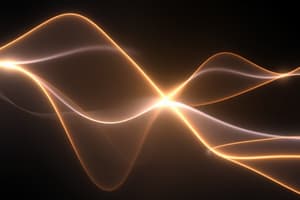Podcast
Questions and Answers
What does the frequency of a wave represent?
What does the frequency of a wave represent?
- The number of oscillations per unit time (correct)
- The wavelength of the wave
- The speed of the wave
- The color of the wave
How does high energy light like UV light affect electrons?
How does high energy light like UV light affect electrons?
- Allows them to escape from the atomic nucleus (correct)
- Causes them to oscillate
- Increases their mass
- Stabilizes them
What effect does visible light have on atoms?
What effect does visible light have on atoms?
- Causes electron transitions without ionization (correct)
- Induces molecular vibrations
- Causes ionization of electrons
- Nothing, it passes through atoms unaffected
How do infrared waves interact with matter?
How do infrared waves interact with matter?
What type of motion do microwaves induce in matter?
What type of motion do microwaves induce in matter?
Why is studying the interaction of light with matter important for chemists?
Why is studying the interaction of light with matter important for chemists?
What does the amplitude of a light wave represent?
What does the amplitude of a light wave represent?
How is intensity related to the amplitude of a light wave?
How is intensity related to the amplitude of a light wave?
Which property of light waves determines how they interact with matter?
Which property of light waves determines how they interact with matter?
What is the relationship between photons and the amplitude of light waves?
What is the relationship between photons and the amplitude of light waves?
What is the role of wavelength in defining a light wave?
What is the role of wavelength in defining a light wave?
How does the number of photons hitting a surface relate to light wave intensity?
How does the number of photons hitting a surface relate to light wave intensity?
Flashcards are hidden until you start studying
Study Notes
Light waves refer to the oscillatory motion of electromagnetic fields, exhibiting both electric and magnetic components that propagate perpendicularly to each other. These waves form the electromagnetic spectrum, which includes various forms of energy such as visible light, ultraviolet (UV) radiation, infrared (IR) radiation, radio waves, microwaves, and others. Understanding light waves is crucial in chemistry, as chemists study how these waves interact with atoms and molecules to provide information about their structure and chemical bonds.
Properties of Light Waves
Amplitude
The amplitude of a light wave refers to the maximum displacement from the equilibrium position, representing the peak intensity of the wave. In the context of electromagnetic radiation, the amplitude is often associated with photon energy. However, the relationship between amplitude and energy is not straightforward for light waves since photons are massless particles that do not possess discernible amplitudes. Instead, the intensity of a wave (related to its amplitude) can be approximated by the number of photons hitting a surface or system. This approximation does not hold true when considering individual photons.
Wavelength and Frequency
The wavelength of a light wave is the distance between two consecutive crests or troughs. It is an important factor determining how different types of electromagnetic radiation interact with matter. The frequency of a wave represents the number of oscillations (crests or troughs) that pass a given point in space per unit time. Since energy and frequency are directly proportional, understanding these properties allows chemists to predict the effects various forms of light will have on atoms and molecules.
Interactions with Matter
Light waves, particularly those in the visible spectrum, play a crucial role in chemistry by providing information about molecular structure and chemical bonds through their interactions with matter. Different frequencies of light cause specific effects when absorbed by atoms and molecules:
- High Energy Light: UV light and gamma rays transfer enough energy to electrons, allowing them to escape from the atomic nucleus, resulting in ionization.
- Low Energy Light: Visible light causes electron transitions within atoms without sufficient energy for ionization. Infrared radiation induces molecular vibrations, while microwaves cause rotational motion, and radio waves lead to nuclear spin transitions.
By studying the interaction of light with matter, chemists can gather valuable insights into the behavior of molecules, which is essential for developing new materials, technologies, and applications across various fields.
Studying That Suits You
Use AI to generate personalized quizzes and flashcards to suit your learning preferences.




